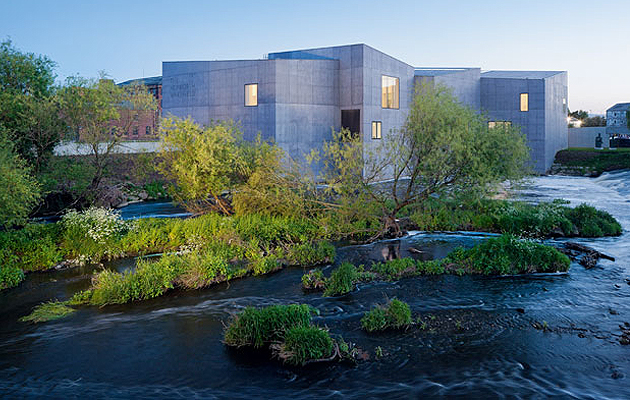|
|
||
|
David Chipperfield Architects has unveiled its second major gallery in the UK, weeks after the opening of Turner Contemporary in Margate (Icon 096). But, at £35m, the Hepworth Wakefield in Yorkshire cost about twice as much as its Kent sibling and is double the size. It needs the extra space. Unlike the Turner, the Hepworth Wakefield has a permanent collection, comprising works by Wakefield-born sculptors Barbara Hepworth and Henry Moore and other pieces from the town council’s art hoard. Several of Hepworth’s full size working models and prototypes in plaster make up part of the permanent collection, alongside drawings and screenprints by the artist. The gallery sits in a tight bend in the Calder river just south of the town centre, beside a busy main road. This prominent site means the building has no real front or back – it’s “a building that has to face all ways”, says Chipperfield. Chipperfield’s concept for the gallery from the first sketches was “a composite form of volumes”: a cluster of pigmented concrete blocks suggestive of the intensely urban industrial setting. The nearby 19th-century mill buildings sit directly on the river front, water washing against their bricks. “I thought that was very powerful,” says Chipperfield, so the gallery also sits in the river like a fortification. Each of the ten blocks in the “composite form” expresses a gallery within. As at Turner Contemporary, Chipperfield has been at pains to provide discrete and approximately orthogonal art spaces within the building, rooms that are “sufficiently interesting, not over-interesting”. The interiors avoid both a clinical obsession with uniform conditions and intrusive over-design. Daylight is carefully introduced through a handful of picture windows and indirectly from recessed rooflights at the peak of each monopitch roof. Chipperfield calls the subtle light from above “church lighting” – a reminder of the outside rather than a bath of light. Doors connecting each room are not aligned into a rigid enfilade: “You’re not just looking at the next room, you’re looking at the next pieces, you’re being led through the space by the art.” It’s a generous and thoughtful building, a civic building in the most authentic way, connected to the town and its artistic heritage rather than making an arrogant independent statement. |
Image Iwan Baan
Words William Wiles |
|
|
||




















